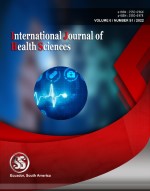Inducible clindamycin resistance in coagulase negative staphylococci
Keywords:
Clindamycin resistance, Erythromycin resistant, Biofilm, D–testAbstract
Induced clindamycin resistance poses a major problem for the use of this drug to treat staphylococcal infections. An infectious etiology is often implicated in the presence of CoNS in clinical specimens. A total of 183 isolates of Staphylococci spp. recovered from different clinical specimens were studied. A coagulase test was done to select coagulase negative Staphylococci, and they were confirmed by conventional microbiological techniques. Using the double disc approximation test, induced clindamycin resistance was detected (D-test). The D test was used to detect the inducible clindamycin resistance phenotype in erythromycin resistant and clindamycin sensitive isolates. A micro titer plate test was used to determine biofilm development in these isolates. One hundred and twenty eight isolates from various clinical specimens were identified as proven CoNS, which were distributed across six different species’. haemolyticus, the most common species of CoNS isolated, was isolated from all types of specimens. The present study revealed the strong association of biofilm with inducible clindamycin resistance among the CoNs isolates.
Downloads
References
Becker K, Heilmann C, Peters G,2014.“Coagulase-negative staphylococci”. Clinical microbiology reviews. 27(4),870-926.
Michalik M, Samet A, Podbielska-Kubera A, Savini V, Międzobrodzki J, Kosecka-Strojek M, 2020. “Coagulase-negative staphylococci (CoNS) as a significant etiological factor of laryngological infections: a review”. Annals of Clinical Microbiology and Antimicrobials. 19(26)1-0.
Ma XX, Wang EH, Liu Y, Luo EJ,2011. ‘’Antibiotic susceptibility of coagulase-negative staphylococci (CoNS): emergence of teicoplanin-non-susceptible CoNS strains with inducible resistance to vancomycin. Journal of medical microbiology.’’1 60(11),1661-8.
Chajęcka-Wierzchowska W, Zadernowska A, Nalepa B, Sierpińska M, Łaniewska-Trokenheim Ł,2015.“Coagulase-negative staphylococci (CoNS) isolated from ready-to-eat food of animal origin–phenotypic and genotypic antibiotic resistance.” Food microbiology.1(46),222-6.
Becker K, Both A, Weißelberg S, Heilmann C, Rohde H, 2020.“Emergence of coagulase-negative staphylococci.” Expert review of anti-infective therapy.18(4),349-66.
De Oliveira A, Cataneli Pereira V, Pinheiro L, MoraesRiboli DF, Benini Martins K, da Cunha RD, De Lourdes M,2016.“Antimicrobial resistance profile of planktonic and biofilm cells of Staphylococcus aureus and coagulase-negative staphylococci”. International journal of molecular sciences.17(9), 1423.
Deyno S, Fekadu S, Seyfe S,2018.“Prevalence and antimicrobial resistance of coagulase negative staphylococci clinical isolates from Ethiopia: a meta-analysis”. BMC microbiology. 18(1), 1-1.
Soares LC, Pereira IA, Pribul BR, Oliva MS, Coelho SM, Souza M, 2012.“Antimicrobial resistance and detection of mecA and blaZ genes in coagulase-negative Staphylococcus isolated from bovine mastitis”. Pesquisa Veterinária Brasileira. 32(8), 692-6.
Michels R, Last K, Becker SL, Papan C,2021. “Update on Coagulase-Negative StaphylococciWhat the Clinician Should Know”. Microorganisms. 9(4),830.
Kürekci C.,2016.“Prevalence, antimicrobial resistance, and resistant traits of coagulase-negative staphylococci isolated from cheese samples in Turkey”,Journal of dairy science. 99(4), 2675-9.
Dibah S, Arzanlou M, Jannati E, Shapouri R,2014.“Prevalence and antimicrobial resistance pattern of methicillin resistant Staphylococcus aureus (MRSA) strains isolated from clinical specimens in Ardabil, Iran.” Iranian journal of microbiology. 6(3),163.
Levin TP, Suh B, Axelrod P, Truant AL, Fekete T,2005.“Potential clindamycin resistance in clindamycin-susceptible, erythromycin-resistant Staphylococcus aureus: report of a clinical failure”. Antimicrobial agents and chemotherapy. 49(3),1222-4.
Stepanović S, Vuković D, Hola V, Bonaventura GD, Djukić S, Ćirković I, Ruzicka F,2007.“Quantification of biofilm in microtiter plates: overview of testing conditions and practical recommendations for assessment of biofilm production by staphylococci”. Apmis. 115(8),891-9.
McManus BA, Coleman DC, Deasy EC, Brennan GI, O’Connell B, Monecke S, Ehricht R, Leggett B, Leonard N, Shore AC,2015. “Comparative genotypes, staphylococcal cassette chromosome mec (SCCmec) genes and antimicrobial resistance amongst Staphylococcus epidermidis and Staphylococcus haemolyticus isolates from infections in humans and companion animals”. PloS one. 10(9). e0138079.
Ohara-Nemoto Y, Haraga H, Kimura S, Nemoto TK, 2008.“ Occurrence of staphylococci in the oral cavities of healthy adults and nasal–oral trafficking of the bacteria”. Journal of Medical Microbiology. 57(1),95-9.
Pal N, Sharma B, Sharma R, Vyas L,2010.“Detection of inducible clindamycin resistance among Staphylococcal isolates from different clinical specimens in western India”. Journal of postgraduate medicine. 56(3),182.
Sun X, Lin ZW, Hu XX, Yao WM, Bai B, Wang HY, Li DY, Chen Z, Cheng H, Pan WG, Deng MG, 2018. “Biofilm formation in erythromycin-resistant Staphylococcus aureus and the relationship with antimicrobial susceptibility and molecular characteristics”. Microbial pathogenesis. 1(124),47-53.
RF RM, Barre FF, Finland M.1968.“Resistance of Staphylococcus aureus to lincomycin, clinimycin, and erythromycin”. Antimicrobial agents and chemotherapy. 8, 392-7.
Chaudhary NKand Piya R,2021. “Macrolide-Lincosamide-Streptogramin B Resistance Among Staphylococcus aureus In Chitwan Medical College Teaching Hospital, Nepal”. Asian Journal of Pharmaceutical and Clinical Research.14(5), 61-5.
Ghasemian A, Peerayeh SN, Bakhshi B, Mirzaee M. 2016, “Comparison of biofilm formation between methicillin-resistant and methicillin-susceptible isolates of Staphylococcus aureus ”.Iranian biomedical journal.20(3),175.
Lotfi GH, Hafida HA, Nihel KL, Abdelmonaim KH, Nadia AI, Fatima NA, Walter ZI,2014.“Detection of biofilm formation of a collection of fifty strains of Staphylococcus aureus isolated in Algeria at the University Hospital of Tlemcen”. African Journal of Bacteriology Research. 6(1),1-6.
Published
How to Cite
Issue
Section
Copyright (c) 2022 International journal of health sciences

This work is licensed under a Creative Commons Attribution-NonCommercial-NoDerivatives 4.0 International License.
Articles published in the International Journal of Health Sciences (IJHS) are available under Creative Commons Attribution Non-Commercial No Derivatives Licence (CC BY-NC-ND 4.0). Authors retain copyright in their work and grant IJHS right of first publication under CC BY-NC-ND 4.0. Users have the right to read, download, copy, distribute, print, search, or link to the full texts of articles in this journal, and to use them for any other lawful purpose.
Articles published in IJHS can be copied, communicated and shared in their published form for non-commercial purposes provided full attribution is given to the author and the journal. Authors are able to enter into separate, additional contractual arrangements for the non-exclusive distribution of the journal's published version of the work (e.g., post it to an institutional repository or publish it in a book), with an acknowledgment of its initial publication in this journal.
This copyright notice applies to articles published in IJHS volumes 4 onwards. Please read about the copyright notices for previous volumes under Journal History.
















